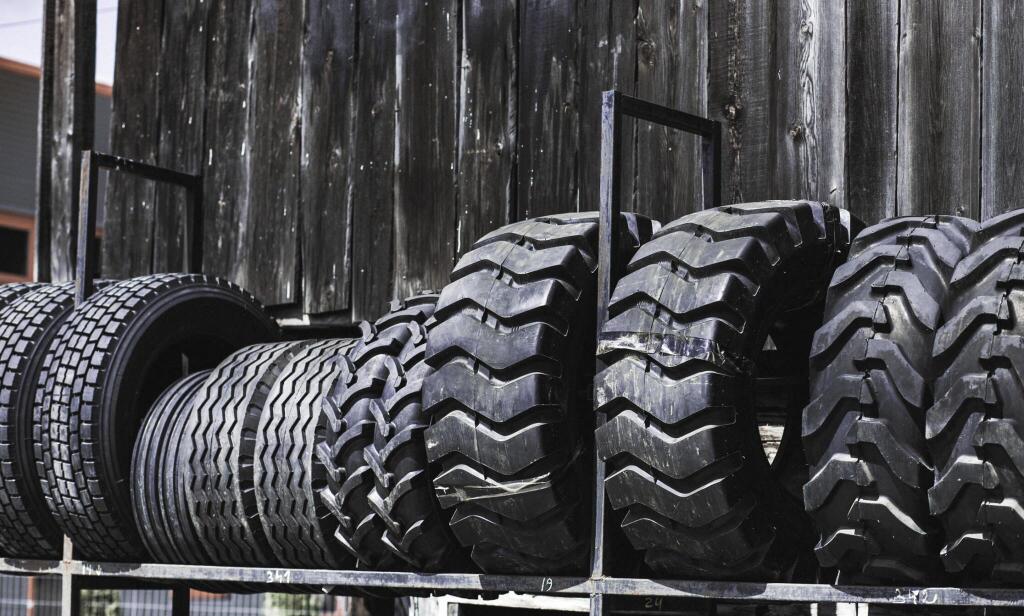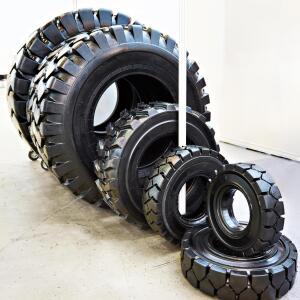Last Updated on September 20, 2025
Understanding Truck Tire Sizes and Their Impact on Performance
Trucks and other heavy-duty vehicles have an astounding range of tire sizes. It is apparent to the inexperienced spectator and the seasoned trucking professional that vehicles are furnished with various tire sizes. However, why is this the case, and is it relevant? This section will discuss the relevance of tire size diversity and its vital importance for trucks.
Tire Size Diversity
Tire size diversity refers to the multitude of options available regarding the dimensions of truck tires. These dimensions are typically expressed as a combination of numbers and letters, such as 275/70R22.5. Let us break down what these numbers mean:
- 275 represents the tire’s width in millimeters. In this example, it’s 275 millimeters.
- 70 is the aspect ratio, indicating the tire’s profile height as a percentage of its width. It’s 70%, meaning the profile height is 70% of 275 millimeters.
- R signifies the tire’s radial construction.
- 22.5 is the diameter of the wheel the tire fits, measured in inches.
Imagine the changes that result from adjusting these letters and numbers. The wide range of tire sizes results from various factors, such as wider tires for better traction, lower aspect ratios for improved stability, and varying wheel diameters for particular truck designs.
Importance Of Tire Size Diversity For Trucks
Understanding the importance of truck tire size diversity is pivotal for efficient and safe operations. Here is why it matters:
- Load Capacity: Trucks are used for various purposes, from transporting goods to hauling heavy loads. The size of the tires directly impacts the vehicle’s load-carrying capacity. Choosing the right tire size ensures that a truck can safely and effectively carry its intended load without compromising stability or safety.
- Traction and Performance: Different tire sizes differ in performance and traction. Tire sizes for highway trucks differ from those traveling on rough terrain. The selection of tire size directly impacts a truck’s grip on the road, which affects handling, braking, and acceleration.
- Fuel Efficiency: Tire size can impact your truck’s fuel efficiency. Larger tires provide better highway fuel economy due to lower rolling resistance, while smaller tires are more suitable for stop-and-go urban driving. Selecting the correct tire size can help optimize a truck’s fuel consumption, reducing operational costs.
- Safety: Safety is paramount in the trucking industry. Incorrect tire sizes can lead to handling issues, decreased braking performance, and increased risk of accidents. Ensuring the proper tire size for a specific truck model and application is essential to maintain safe driving conditions.
- Durability and Longevity: Matching the correct tire size to the truck’s planned function can extend tire life. Truck owners may incur higher maintenance expenditures due to uneven wear and early tire replacement caused by oversized or undersized tires.
Tire size diversity in the trucking industry is about optimizing trucks’ performance, safety, and efficiency across various applications—rather than just offering more alternatives for the sake of having more. Truck owners and operators will be able to make well-informed decisions for their unique requirements as we go deeper into the range of tire sizes available for trucks and the elements that influence their selection in the upcoming blog sections.
Understanding Tire Size Basics
Understanding the basics of tire size is crucial when choosing the right tires for your truck. Tire size notations may seem like a cryptic combination of numbers and letters, but they convey essential information about the tire’s characteristics. In this section, we will decode tire size notations and explore the significance of diameter, width, and aspect ratio in tire selection.
Decoding Tire Size Notations
Tire size notations can vary but typically follow a standardized format: 275/70R22.5. Let’s break down each component:
- The tire’s width is 275 millimeters.
- The aspect ratio is 70%, representing the profile height as a percentage of the width.
- The “R” signifies radial construction.
- The wheel diameter is 22.5 inches.
Understanding these numbers is crucial because they dictate how a tire will perform and fit on your truck. Here’s a closer look at each aspect:
- Width (275 mm): The tire’s width affects its contact patch with the road. Wider tires provide more contact area, which can enhance traction and stability. However, they may also increase rolling resistance, impacting fuel efficiency. Narrower tires, on the other hand, may improve fuel economy but may have reduced traction.
- Aspect Ratio (70%): The aspect ratio indicates the tire’s profile height relative to its width. A lower aspect ratio, like 70%, means a shorter sidewall and a more “low-profile” appearance. Low-profile tires often provide better cornering stability but may result in a firmer ride.
- Diameter (22.5 inches): To ensure a proper fit, the wheel diameter should match the tire’s diameter. A larger wheel diameter often accommodates more significant brake components, improving braking performance. However, selecting a diameter that suits your truck’s design and intended use is essential.
The Role of Diameter, Width, and Aspect Ratio
These three aspects—diameter, width, and aspect ratio—play a crucial role in how a tire performs on your truck:
- Handling and Stability: W wider tires with lower aspect ratios sometimes provide better handling and cornering stability for sportier driving. On the other hand, trucks with larger sidewalls (higher aspect ratios) have the potential to absorb more shock and offer a smoother ride, which makes them perfect for heavy-duty applications or off-roading.
- Braking and Acceleration: Performance in braking and acceleration can be improved with larger-diameter tires. More stopping power is possible because they provide the brakes with a longer lever arm. Larger-diameter tires also improve acceleration since they can cover more ground with each revolution.
- Fuel Efficiency: Your tire size can impact fuel efficiency. Smaller diameter and narrower tires typically result in less rolling resistance, which can contribute to better fuel economy. However, the trade-off may be reduced traction and handling, especially in adverse conditions.
- Load-Carrying Capacity: The right tire size is essential for matching your truck’s load-carrying capacity. Tires with appropriate width and aspect ratio can ensure your vehicle can safely carry its intended load without compromising stability.
Variety in Truck Tire Sizes
There is a wide range of truck tire sizes to meet the various requirements of both light- and heavy-duty trucks. The range of truck tire sizes is not random; instead, it responds to the multiple needs of different truck kinds and their purposes. The differences between light- and heavy-duty trucks and the availability of specific tire sizes for distinct truck functions will be the main topics of discussion as we examine the variety of truck tire sizes in this section.

Light Trucks vs. Heavy-Duty Trucks
Light trucks are generally designed for lighter loads and everyday use, often featuring smaller, less robust tires than heavy-duty trucks. In contrast, heavy-duty trucks are built for hauling large loads or performing demanding tasks, necessitating larger, more durable tires with higher load ratings.
- Light Trucks: Light trucks, including pickup trucks and SUVs, typically require different tire sizes than their heavier counterparts. Light truck tires are designed to balance comfort, fuel efficiency, and load-carrying capacity. They often have smaller diameters and narrower widths compared to heavy-duty truck tires. This design allows for a smoother ride and improved fuel economy while still being able to handle moderate loads.
- Heavy-Duty Trucks: On the other hand, heavy-duty trucks, such as semi-trucks and commercial vehicles, demand a completely different class of tire sizes. These trucks are built for heavy hauling and long-distance travel. Consequently, their tire sizes are more significant in diameter and width. Larger tires offer enhanced load-carrying capacity and stability, making them suitable for the rigorous demands of the transportation industry.
Specialized Tire Sizes for Different Truck Functions
More significantly, wider tires are usually used for heavy-duty applications to boost stability and load capacity. Specialized tire sizes are designed to accommodate various truck functions. Light-duty trucks’ smaller tires are more agile and fuel-efficient in cities and other less demanding conditions.
- Off-Road and All-Terrain Trucks: Trucks used for off-road adventures, construction, or agriculture require specialized tire sizes that can handle rugged terrains. These tires often feature aggressive tread patterns, reinforced sidewalls, and more extensive profiles for maximum traction and durability.
- Highway Trucks: Tire sizes on trucks meant for long-distance highway travel must be maximized for both longevity and fuel economy. Larger diameters and narrower widths are characteristic features of these tires, which lower rolling resistance and increase mileage.
- Regional and Urban Delivery Trucks: Tire sizes for trucks operating in regional or urban delivery services must compromise load capacity and mobility. These vehicles’ tires are often in the middle of light—and heavy-duty truck tires so that they can maneuver through city streets with substantial payloads.
- Specialized Applications: Certain trucks, such as fire trucks, cement mixers, and garbage trucks, have particular uses. Custom tire sizes may be fitted to these vehicles to satisfy their unique operational needs.
The variety in truck tire sizes is a testament to these vehicles’ adaptability to diverse tasks and terrains. Whether light trucks for everyday commuting or heavy-duty trucks for long-haul transportation, the correct tire size is essential to ensure optimal performance and safety.
Factors Influencing Tire Size Variety
It is not by accident that vehicles come with such an extensive range of tire sizes. Instead, it’s a deliberate reaction to several variables that affect tire size choices. In this part, we will examine the significant elements crucial in deciding the range of truck tire sizes. These variables include the make and model of the vehicle, its intended use and load distribution, and its fuel economy and traction requirements.
Vehicle Design and Purpose
Vehicle design and purpose significantly influence its features and capabilities. For example, a truck designed for off-road use will have a robust suspension and 4WD, while a city car focuses on compactness and maneuverability.
- Design and Body Style: A truck’s design and style significantly impact the tire size choice. For instance, a sleek and sporty pickup truck may have broader, low-profile tires to enhance aesthetics and handling. In contrast, a heavy-duty work truck may opt for larger, more robust tires capable of withstanding heavy loads and challenging terrains.
- Suspension System: A truck’s type of suspension system can influence tire size. Trucks with off-road capabilities often feature raised suspensions, allowing for larger tire sizes that can provide greater ground clearance and off-road traction.
- Intended Use: Whether a truck is designed for daily commuting, long-haul transport, off-road adventures, or specific work applications profoundly impacts tire size selection. Trucks intended for specialized purposes require tire sizes tailored to their unique functions.
Load Capacity and Distribution
Vehicle performance and stability are greatly dependent on load capacity and distribution. The appropriate Weight distribution for the vehicle maximizes its carrying capacity while maintaining structural integrity and safety.
- Weight Distribution: It is essential to distribute weight evenly among a truck’s axles. Choosing tire sizes that will sustain this distribution evenly is necessary. Uneven weight distribution or overloading can cause tires to wear down sooner and compromise safety.
- Load-Carrying Capacity: Tire size directly impacts how much weight it can support. Larger tires with reinforced sidewalls are necessary for heavy-duty trucks carrying heavy loads because they can handle the additional strain. Smaller tires that are appropriate for their load-carrying capabilities may be found on lighter trucks.
Fuel Efficiency and Traction Needs
Fuel efficiency is a crucial factor in car design, and it’s frequently attained with lightweight materials and aerodynamic shaping. Tire selection and drive systems—front-wheel, rear-wheel, or all-wheel drive—are dictated by traction requirements, which are established by the planned use of the vehicle.
- Fuel Efficiency: Fuel Efficiency is paramount for many truck owners, particularly business owners. Tire size influences rolling resistance, with narrower tires often offering higher highway fuel economy. Truck manufacturers take this into account when choosing tire sizes for particular models.
- Requirements for Traction: The type of truck used determines the criteria for traction. Tire sizes with aggressive tread patterns and more extended profiles may be necessary for trucks that routinely travel through unfavorable weather, off-road terrain, or construction sites to guarantee maximum traction.
- Climate Considerations: Climate plays a role in tire size selection. In regions with extreme weather, such as snow or ice, trucks may be equipped with winter-specific tires with unique size requirements to enhance grip and safety.
The variety of truck tire sizes results from careful consideration of factors like vehicle design and purpose, load capacity and distribution, and the need for fuel efficiency and traction. Each truck model is meticulously engineered to meet specific requirements, and tire size is crucial in achieving optimal performance and safety for diverse trucking applications. Understanding these factors is essential for truck owners and operators to make informed choices when selecting the right vehicle tires.
Impact of Tire Sizes on Truck Performance
The size of the tires a truck is riding on significantly impacts its performance. The selection of tire sizes can dramatically affect a truck’s handling, braking, and performance on and off the road. The significant effects of tire sizes on truck performance will be discussed in this part, along with how they affect handling and stability, braking effectiveness, and the differentiation between off-road and on-road performance.
Handling and Stability
Tire type, suspension design, and weight distribution influence vehicle handling and stability. Smooth cornering and stability are ensured by good handling, especially in high-speed or difficult driving situations.
- Handling Precision: The size of a truck’s tires is crucial in determining its handling characteristics. Wider tires with lower aspect ratios often offer improved cornering stability and precision. Trucks with such tires tend to have responsive steering and are more adept at navigating curves.
- Cornering Stability: Trucks with larger tire sizes benefit from a broader contact patch with the road, enhancing cornering stability. This is particularly important for vehicles that need to make sharp turns or maneuver through tight spaces, such as delivery trucks in urban areas.
- Highway vs. Off-Road Handling: Trucks designed for highway use may have tire size requirements different from those built for off-road adventures. While highway trucks prioritize smooth handling on paved roads, off-road trucks require more extensive, robust tires with deep treads for enhanced grip on challenging terrains.
Braking Efficiency
Braking efficiency is vital for vehicle safety. It depends on the quality of brake components, tire grip, and the vehicle’s weight and speed. Regular maintenance of brakes and tires is essential to maintaining optimal stopping power.
- Braking Performance: The effectiveness of a truck’s brakes can be significantly impacted by the size of its tires. Larger-diameter tires frequently provide the brakes more leverage, which improves braking efficiency. This is especially important for heavy-duty trucks with large loads that must be stopped securely.
- Load and Tire Size: A truck’s load-carrying capacity is closely tied to its tire size. Trucks with smaller tires may need to be equipped to handle heavy loads efficiently, affecting their ability to brake effectively. Choosing the right tire size that matches the truck’s intended load is crucial for safe braking.
Off-Road vs. On-Road Performance
Off-road vehicles are designed with higher ground clearance, rugged tires, and robust suspension for uneven terrain. In contrast, on-road vehicles prioritize comfort, fuel efficiency, and smooth handling on paved roads. A car’s design and features significantly influence its performance in these different environments.
- Off-Road Performance: Trucks designed for off-road use need specific tire sizes to handle rough terrain. These tires usually feature stronger sidewalls, deeper treads, and extended profiles to endure harsh conditions. In off-road situations, they offer improved durability and traction.
- On-Road Performance: Tire sizes designed for on-road performance are advantageous for trucks mainly utilized on highways. To reduce rolling resistance and enhance fuel efficiency, these tires frequently feature wider circumferences and smaller widths, which makes for a smoother ride over paved terrain.
- Adaptive Tires: Also known as all-terrain or multi-purpose trucks, particular trucks are designed to balance performance on and off-road. Their tire sizes are selected to provide versatility for a range of driving conditions and to function satisfactorily in both situations.
The Evolution of Tire Sizes in the Trucking Industry
Tire sizes have changed significantly throughout the trucking industry. It’s fascinating to follow the development of tire sizes in the trucking business from modest beginnings to state-of-the-art inventions. This section will examine the historical viewpoints that influenced the tire sizes in use now and the contemporary practices and technical developments that are still transforming the trucking sector.
Historical Perspectives
Throughout history, vehicle design and technology have progressed from simple, manually operated machines to intricate, mechanical systems. Transportation has been transformed, and inventions such as the internal combustion engine and assembly line industry have created contemporary society.
- Early Truck Tires: In the early days of trucking, tire sizes were significantly smaller than we see today. Trucks were lighter, and the tires were designed to meet the basic load-carrying needs. These tires had narrow widths and smaller diameters than contemporary heavy-duty truck tires.
- Bias-Ply Tires: Bias-ply tires were the norm in the mid-20th century. They featured a unique construction with crisscrossing layers of fabric cords. While they were suitable for their time, these tires had limitations regarding load-carrying capacity and durability.
- Transition to Radial Tires: Radial tires were crucial. Radial tires provide increased load-carrying capacity, longevity, and durability. With cables extending perpendicular to the direction of movement, their unique internal construction offered better handling and stability.
Modern Trends and Technological Advancements
Modern trends in vehicle technology emphasize automation, connectivity, and sustainability. Advancements like electric powertrains, autonomous driving systems, and intelligent connectivity features are transforming how vehicles are used and interact with their environment, leading toward a more efficient, safer, and eco-friendly future in transportation.
- Larger Diameter Tires: One notable trend in modern truck tires is the increase in tire diameter. Larger-diameter tires have become more prevalent, especially in heavy-duty trucks. These tires provide better ground clearance, accommodate more significant brake components, and offer improved braking performance.
- Wider Tires: The width of truck tires has also expanded. Wider tires offer a larger contact patch with the road, improving traction, stability, and load-carrying capacity. They have become famous for trucks that require enhanced performance.
- High-Tech Materials: Modern tire manufacturing involves using advanced materials and technology. High-tech materials like silica compounds, reinforced steel belts, and specialized rubber compounds enhance tire performance, durability, and fuel efficiency.
- All-Season and Specialized Tires: The trucking industry has witnessed the development of all-season tires that are versatile enough to handle various weather conditions. Additionally, specialized tires designed for specific purposes, such as winter tires for icy conditions or off-road tires for rugged terrains, have become more prevalent.
- Smart Tire Technology: Technological advancements have given rise to intelligent tire technology. These tires have real-time sensors that monitor tire pressure, temperature, and even tread wear. This technology improves safety and helps prevent tire-related accidents.
- Eco-Friendly Tires: With a growing emphasis on environmental sustainability, eco-friendly tires have emerged. These tires are designed to reduce rolling resistance, improve fuel efficiency, and reduce carbon emissions.
Choosing the Right Tire Size for Your Truck
Selecting the correct tire size for your truck profoundly impacts its performance, safety, and efficiency. This section will delve into the essential steps and considerations when choosing the right tire size for your vehicle. Understanding your truck’s requirements, navigating manufacturer recommendations, and gaining professional insights and tips are all crucial aspects of this decision-making process.

Understanding Your Truck’s Requirements
Knowing your truck’s weight capacity, the types of terrain it will drive on, and the particular maintenance requirements for your model and usage will help you understand what your truck needs. This information is necessary for the truck to operate at its best and last longer.
- Vehicle Type: Your truck type significantly influences the tire size choice. Light trucks, heavy-duty trucks, SUVs, and specialized vehicles have distinct tire size requirements. Determine your truck’s category to narrow down your options.
- Intended Use: Consider how you plan to use your truck. Will it primarily be used for highway driving, off-road adventures, heavy hauling, or daily commuting? Each use case may require a different tire size to optimize performance.
- Load-Carrying Capacity: Assess your truck’s maximum load. Consult your truck’s documentation or manufacturer recommendations to determine the load-carrying capacity required. Overloading tires can lead to premature wear and decreased safety.
Navigating Manufacturer Recommendations
Navigating manufacturer recommendations requires consulting the truck’s manual for guidelines on maintenance schedules, part replacements, and ideal operating conditions. Adhering to these recommendations ensures the vehicle runs efficiently and remains under warranty.
- Check the Owner’s Manual: Your truck’s owner’s manual is invaluable for finding manufacturer-recommended tire sizes. It provides specifications and guidelines tailored to your specific truck model.
- Tire Placard: Inspect your truck’s tire placard, often located on the driver’s side door frame or inside the glove compartment. It provides the recommended tire size, load index, and tire pressure information.
- Online Tools: Many tire manufacturers and retailers offer online tools and databases to help you find the right tire size for your truck. Enter your truck’s make, model, and year for tailored recommendations.
Professional Insights and Tips
Professional insights and tips, often from experienced mechanics or truck specialists, can provide valuable advice on customizing maintenance plans, troubleshooting common issues, and enhancing the truck’s performance tailored to individual needs and usage patterns.
- Consult a Tire Expert: If you need clarification on the best tire size for your truck, consider consulting a tire expert or a professional at a tire shop. They can provide personalized recommendations based on your truck’s requirements and driving habits.
- Consider Upgrades: In some cases, upgrading to a different tire size may improve your truck’s performance. Wider tires can enhance traction, while larger-diameter tires can improve braking efficiency. Discuss potential upgrades with a professional.
- Balance Performance and Comfort: When choosing a tire size, balance performance and comfort. While larger, wider tires may offer superior handling and stability, they may also result in a firmer ride. Consider your comfort preferences when making your decision.
- Think About Seasonal Needs: If you live in an area with distinct seasons, consider investing in seasonal tires. Winter tires, for instance, may require a different size than your all-season or summer tires. Plan accordingly to ensure safety in all weather conditions.
Maintenance and Care for Different Truck Tire Sizes
Proper tire maintenance is essential to ensure the longevity and performance of your truck’s tires. However, when dealing with different tire sizes, there are specific considerations to remember. In this section, we will delve into the details of maintaining and caring for tires of varying sizes, focusing on regular checks, balancing, and the impact of tire size on wear and tear.
Regular Checks:
Checking the brake system, tires, engine oil levels, and lights are all routine truck maintenance procedures. Monitoring ensures safety and increases the vehicle’s lifespan by assisting in the early detection of possible problems.
- Inflation Pressure: Correct inflation pressure is crucial regardless of tire size. Different tire sizes may have varying recommended pressures, so always refer to your truck’s manual or the manufacturer’s guidelines. Under-inflated tires can lead to increased wear, reduced fuel efficiency, and poor handling.
- Tread Depth: Check the tread depth regularly using a tread depth gauge. Different tire sizes will have different initial tread depths, so be aware of your specific tires’ minimum acceptable tread depth. Worn-out treads can compromise traction and safety.
- Visual Inspection: Inspect the tires for visible damage, such as cuts, punctures, or bulges. Different tire sizes may encounter various road hazards, so vigilance is vital. Address any visual issues promptly to prevent further damage.
- Alignment: Ensure that your truck’s wheels are correctly aligned. Misalignment can lead to uneven tire wear, regardless of tire size. Regular alignment checks can help prolong tire life.
Balancing:
Tire balancing is crucial for even tire wear and smooth driving. Unbalanced tires can lead to vibration, faster tread wear, and strain on the vehicle’s suspension system, impacting overall ride quality.
- Dynamic Balancing: Balancing is essential to distribute weight evenly across the tire. Different tire sizes may have variations in weight distribution, so it’s crucial to use dynamic balancing equipment designed for your specific tires. Properly balanced tires result in a smoother ride and reduced wear.
- Wheel Size Compatibility: When replacing or changing tire sizes, ensure the new tires are compatible with your truck’s wheels. Mismatched sizes can lead to balance issues, vibrations, and premature wear.
Impact of Tire Size on Wear and Tear:
The tire size can significantly affect a truck’s wear and tear. Larger or wider tires may provide better stability but can increase strain on the suspension and brakes. In comparison, smaller tires might offer less resistance but potentially less grip and stability.
- Load-Bearing Capacity: Larger tire sizes often have a higher load-bearing capacity. This can be advantageous for trucks that frequently carry heavy loads. However, matching the tire size to the truck’s load requirements is essential to avoid overloading and excessive wear.
- Tread Life: Different tire sizes may have varying tread life expectations. Larger tires may have a longer tread life due to increased surface area. However, it’s essential to consider the truck’s usage and ensure that the chosen tire size aligns with its intended purpose.
- Road Conditions: Tire size can impact how a truck handles various road conditions. Smaller tires provide better maneuverability, while larger tires may excel in off-road situations. Consider the typical driving conditions your truck encounters when selecting tire sizes.
Regulations and Standards in Truck Tire Sizes
Several industry standards determine truck tire sizes and are essential to performance and road safety. This part will examine the complex web of rules and regulations controlling truck tire sizes, along with industry norms and compliance requirements mandated by the law.
Industry Standards:
Industry truck maintenance and manufacturing standards guarantee effectiveness, safety, and quality. Established by trade associations and industry specialists, these standards direct vehicle design, material selection, and performance benchmarks to ensure uniform quality throughout the industry.
- Tire Size Nomenclature: The truck tire industry follows a standardized nomenclature for tire sizing. This vocabulary includes tire width, aspect ratio, and rim diameter metrics. For example, a standard notation is P215/65R15, where each component signifies a specific aspect of the tire’s size.
- Load and Speed Ratings: Truck tires are assigned load and speed ratings according to industry standards. Load ratings indicate the maximum weight a tire can carry, while speed ratings denote the top safe speed at which a tire can operate. These ratings are standardized to ensure uniformity and safety.
- Uniform Tire Quality Grading (UTQG): UTQG ratings provide information about a tire’s treadwear, traction, and temperature resistance. These standardized ratings help consumers decide when to select tires based on performance characteristics.
Legal Requirements and Compliance:
The legal requirements and truck compliance cover emissions, safety features, and regular inspections. You should adhere to these laws and regulations for legal operation, road safety, and environmental responsibility, varying depending on region and vehicle type.
- Federal Motor Vehicle Safety Standards (FMVSS): In the United States, truck tire sizing is regulated by the FMVSS, a set of safety standards established by the National Highway Traffic Safety Administration (NHTSA). FMVSS includes specific requirements for tire construction, performance, and labeling.
- Load Capacity: Legal guidelines usually specify the minimum load-carrying capacity that truck tires must meet. The size and structure of the tire determine its capacity; exceeding this limit might result in safety risks and legal ramifications.
- Tire Labeling: Truck tires must be legally labeled with all pertinent information, such as size, load rating, speed rating, and other parameters. This labeling ensures transparency and helps customers select the appropriate car tires.
- DOT Certification: The Department of Transportation (DOT) certification is required for all tires sold in the United States. Tires must meet specific safety and quality standards to receive DOT certification, ensuring compliance with legal requirements.
- State-Specific Regulations: In addition to federal regulations, some states may have specific requirements or restrictions on truck tire sizing. Truck operators should be aware of and adhere to these state-level regulations to avoid legal issues.
- International Regulations: Knowing tire sizing regulations in different countries is essential for international trucks. These regulations may vary, and compliance is necessary to ensure safe and legal operation.

Conclusion & Recommendations
This extensive guide to truck tire sizes has examined many aspects of this critical truck upkeep and functionality component. Let’s review the main ideas raised and provide advice on how to choose the right tires for your truck.
Recap of Key Points:
This discussion has covered various aspects of truck maintenance and operation, emphasizing the importance of understanding truck requirements, adhering to manufacturer recommendations, and the impact of factors like tire size and balancing on wear and tear. Additionally, the significance of complying with industry standards and legal requirements to ensure safety, efficiency, and legal compliance has been highlighted.
- Understanding Tire Size Basics: We began by deciphering the complex world of tire size notations, emphasizing the role of diameter, width, and aspect ratio.
- Variety in Truck Tire Sizes: We highlighted the diversity of tire sizes, differentiating between light and heavy-duty trucks, and explored specialized tire sizes for specific truck functions.
- Factors Influencing Tire Size Variety: We discussed how vehicle design, load capacity, and traction needs impact tire size choices.
- Impact of Tire Sizes on Truck Performance: We delved into how tire sizes affect handling, stability, braking, and performance in various road conditions.
- The Evolution of Tire Sizes: We examined the historical evolution of tire sizes in the trucking industry and considered modern trends and technological advancements.
- Choosing the Right Tire Size: We provided insights into selecting the appropriate tire size by understanding your truck’s requirements and following manufacturer recommendations.
- Maintenance and Care for Different Tire Sizes: We explored the importance of regular checks and balances and the impact of tire size on wear and tear.
- Regulations and Standards in Truck Tire Sizing: We emphasized the significance of adhering to industry standards and legal requirements for truck tire sizing.
Future Outlook on Truck Tire Sizes:
The future of truck tire sizes is poised for continuous innovation and improvement. With advancements in tire technology, we can expect the following:
- Enhanced Durability: Truck tire manufacturers are constantly researching and developing materials and designs to extend tire lifespans and reduce the frequency of replacements.
- Efficiency Improvements: Future truck tire sizes will likely be designed for improved fuel efficiency, contributing to cost savings and reduced environmental impact.
- Incorporation of Smart Technology: Tire manufacturers are exploring the integration of sensors and intelligent technology to provide real-time data on tire performance, enabling proactive maintenance.
- Sustainability: There is a growing emphasis on producing eco-friendly tires, utilizing recycled materials and sustainable manufacturing processes.
- Customization: Tailored tire sizing options may become more prevalent, allowing truck owners to optimize their tires for specific applications and conditions.
Recommendations:
For the best possible truck operation and maintenance, it is advised to routinely inspect and maintain vital parts, including tires, brakes, and engines. Keep yourself updated about regulatory requirements and industry norms. Seek professional advice related to your truck model and usage. Put efficiency and safety first to guarantee dependable and durable performance.
- Regular Maintenance: Regardless of tire size, prioritize regular maintenance, including proper inflation, alignment checks, and visual inspections, to ensure optimal tire performance.
- Compliance: Always adhere to industry standards and legal requirements regarding tire size and load capacity to maintain safety and compliance.
- Select Wisely: When choosing truck tire sizes, consider your truck’s intended use and the road conditions it will encounter. Consult with experts if needed.
- Stay Informed: Keep up with tire industry advancements to make informed decisions about when to replace your truck’s tires.
Why Tires Easy Truck
Ready to equip your truck with the right tires? Look no further than Tires Easy Truck. We offer a wide range of truck tire sizes, ensuring you’ll find the perfect fit for your vehicle. Don’t compromise on safety and performance—explore our selection today and make the road ahead a smooth and secure journey. Click the button below to browse our catalog and find the ideal tires for your truck.
With the correct tire size and upkeep, you will enjoy a smoother ride, more fuel efficiency, and increased safety on the road. Tires Easy Truck is your reliable partner for all trucking needs, so invest in high-quality truck tires.
FAQs:
How will bigger tires affect my truck?
Larger tires may reduce your truck’s performance. Although they can decrease acceleration and fuel efficiency, they can also increase off-road ability and ground clearance. Make sure they meet your truck’s requirements.
What are the effects of different tire sizes?
Variations in tire size can affect load capacity, handling, and traction. Larger sizes can improve off-road capability and weight-carrying capacity, while smaller sizes provide superior maneuverability.
What are the different tire sizes for trucks?
Truck tires come in various sizes, including 265/70R17 and 285/75R16. The choice depends on your truck’s make, model, and intended use.
What can wrong-sized tires cause?
Wrong-size tires can lead to safety risks, including poor handling, reduced braking efficiency, and potential damage to your truck’s components. It’s crucial to select the right size for optimal performance.
What is the best tire size for a truck?
The best tire size for your truck depends on your specific needs. Consult your truck’s manual and consider factors like load capacity, road conditions, and driving preferences to determine the ideal size.
How are truck tires sized?
Truck tires are sized based on a standardized notation that includes width, aspect ratio, and rim diameter. For example, in size P265/70R17, “P” represents the tire type, “265” is the width in millimeters, “70” is the aspect ratio, and “17” is the rim diameter.
Why put bigger tires on a truck?
Larger tires are frequently used for excellent off-road performance, more ground clearance, and a more rugged look. However, it is crucial to consider any potential trade-offs in handling and fuel efficiency.
Does tire size matter on a truck?
Yes, tire size matters on a truck. It affects various aspects, including performance, safety, and fuel efficiency. Selecting the right size is crucial for optimizing your truck’s capabilities.










